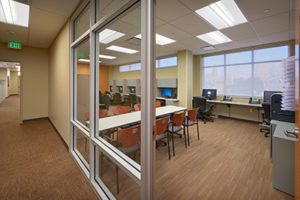Team-Based Health Care: Improved Patient Experience by Design
By John C. Hoelscher
Team-based health care provides health services to individuals and families by a group of health providers who work collaboratively with patients and center care around the patient’s individual needs. This delivery model makes shared goals a priority in order to achieve coordinated, high-quality care. Growing in popularity due to mounting evidence of enhanced patient experience, this health care model is now used in several Colorado health care facilities.

Photo Credit: RTA Architects
In the team-based delivery model, providers are the leaders of the care team, which includes not only doctors, but also nurses, physical, speech and occupational therapists, and administrative support staff. Its purpose is to create a remarkable patient experience by engaging the patient at every point in the process, providing services to fit the patient’s needs, and making it easy for the patient to access the resources that support lifelong wellness. Colorado Springs, Colo.-based RTA Architects has been fortunate to design transformative health care facilities in the Colorado area based on this model, among them: Craig Hospital, Penrose Hospital, St. Francis Medical Center, Denver Health Southwest Family Health Center and Peak Vista Community Health Centers.
Principles of Team-based Health Care:
• Shared Goals: The team, including the patient and family members, works to establish shared goals that reflect patient and family priorities, which can be clearly articulated, understood and supported by all team members.
• Clear Roles: There are clear expectations for each team member’s functions, responsibilities and accountabilities. This optimizes the team’s efficiency and often makes it possible for the team to take advantage of division of labor.
• Mutual Trust: Team members earn each other’s trust, creating strong norms of reciprocity and greater opportunities for shared achievement.
• Effective Communications: The team prioritizes and continuously refines its communication skills. It has consistent channels for candid and complete communication, which are accessed and used by all team members across all settings.
• Measurable Processes and Outcomes: The team agrees on and implements reliable and timely feedback on successes and failures in both the functioning of the team and achievement of the team’s goals. These are used to track and improve performance immediately and over time.
When designing a team-based health care facility, the focus must be upon facilitating the collaborative effort among the care team members to promote health through prevention, wellness and lifestyle changes— rather than each individual caregiver being responsible only for their own discipline. Staff employs an integrative approach that embraces mind, body and spirit. Architects need to think outside the box of traditional health care delivery. How can we make facilities that are designed for care teams to better collaborate? How far can we go to create easy access and a relaxed, welcoming atmosphere? When working in a medically underserved neighborhood, how can a family- and neighborhood-friendly environment be designed to enhance community participation and pride?
For optimal operational flow among care team members, the clinical pod concept is often used. The entire clinical area is broken into pods that support a given number of exam rooms. Registration areas are conveniently located to serve the clinical pods. The care team in each pod is organized in such a way that the team can have direct line of sight to all exam rooms so that they can respond immediately to patient needs. Care team stations are organized to facilitate collaboration by providing flexible meeting space. Support services such as vital sign stations, soiled holding, clean supplies and medications are positioned to be conveniently accessed by the care team. The pods are connected by an “off-stage” corridor that facilitates staff circulation. The exam rooms are highly flexible spaces that support collaboration between provider and patient by providing sufficient room for family and staff to consult on the best course of treatment.
Understanding that increased staff satisfaction produces better patient outcomes, architects need to remember the needs of the care team when designing staff areas. Designing work and break areas with ample natural light, open floor plans, high ceilings, quiet acoustics and attention to the need for some retreat from patients when needed, enhances staff satisfaction.
One of the most rewarding design tasks is the creation of a one-stop facility that can deliver multiple healthcare services and prescription pickup. When the visit is complete the guest simply leaves the facility without the need to visit additional providers. Welcoming, easily navigated, one-stop facilities help the team-based healthcare model to provide excellent long-term results.
John C. Hoelscher, AIA, ACHA, is a principal at RTA Architects.

